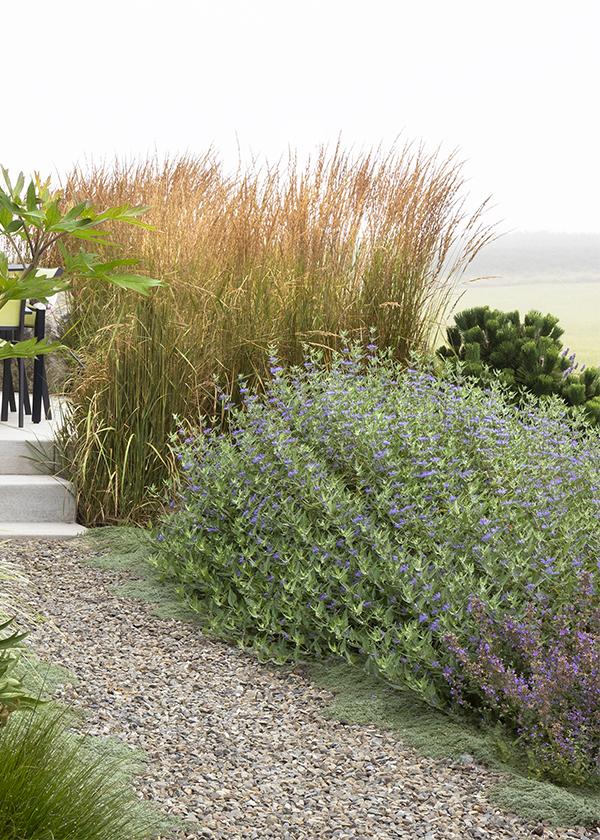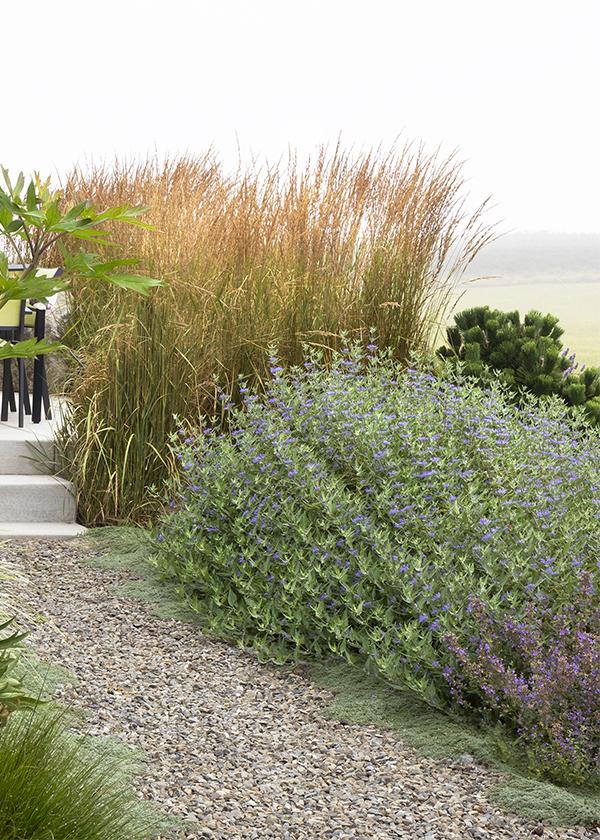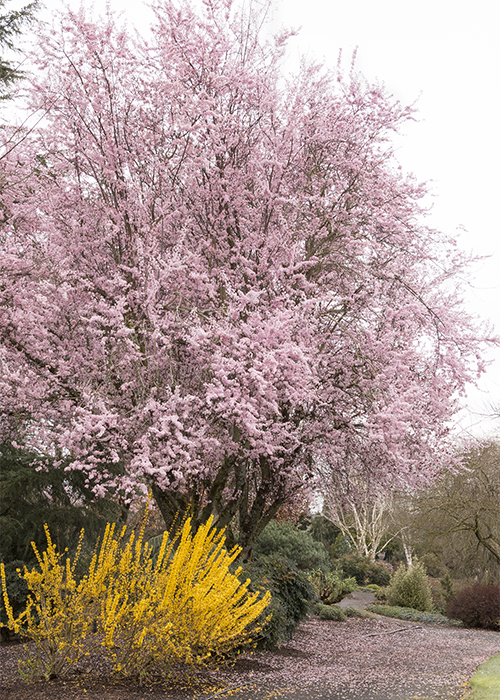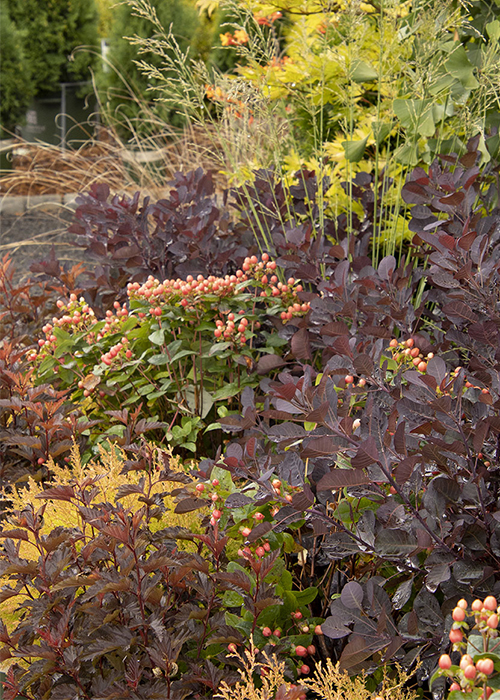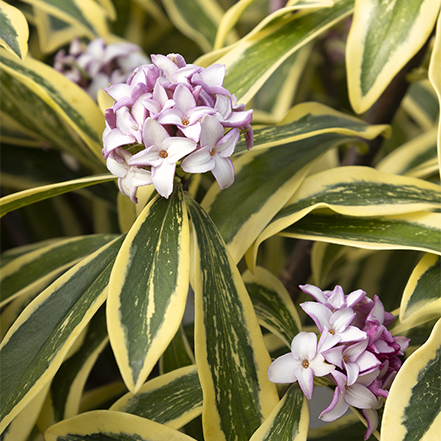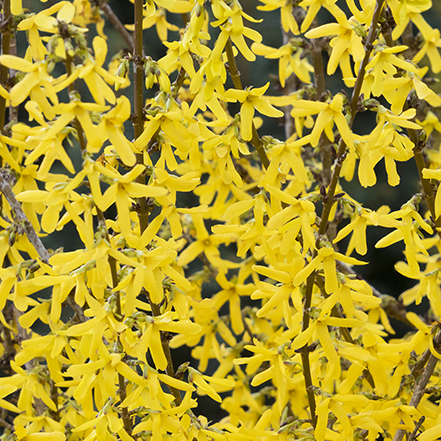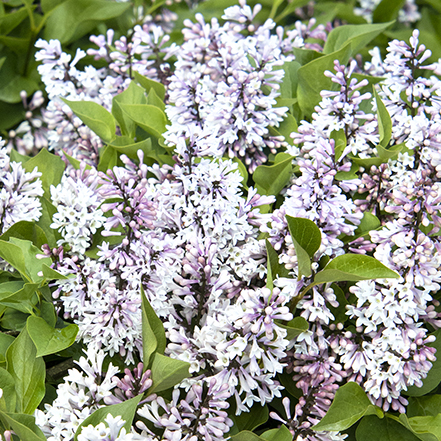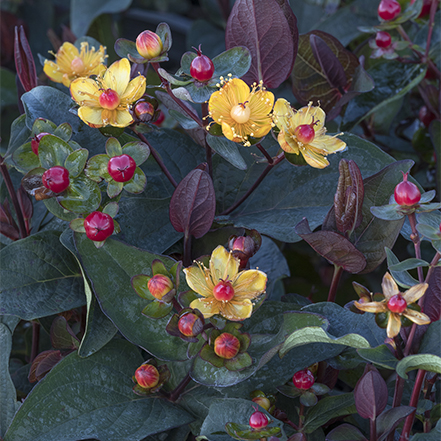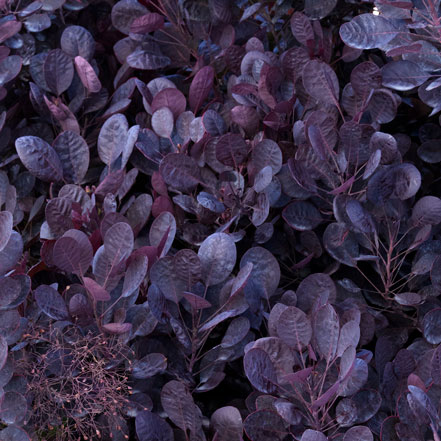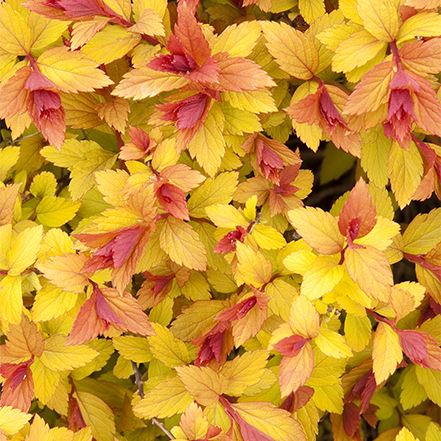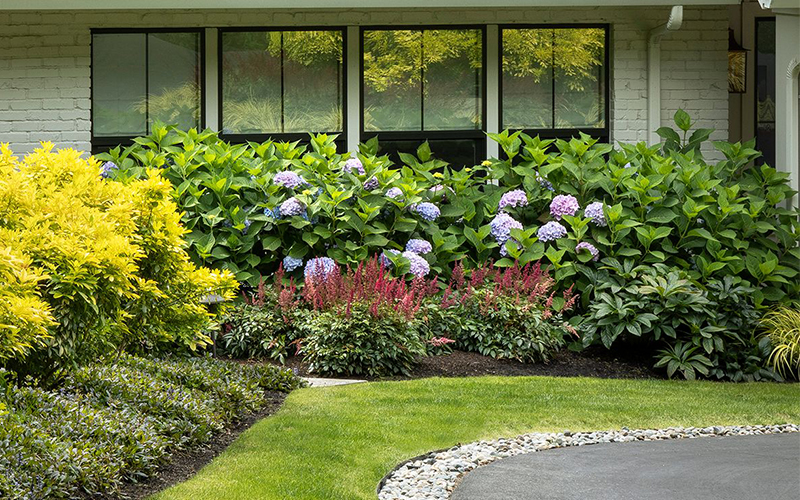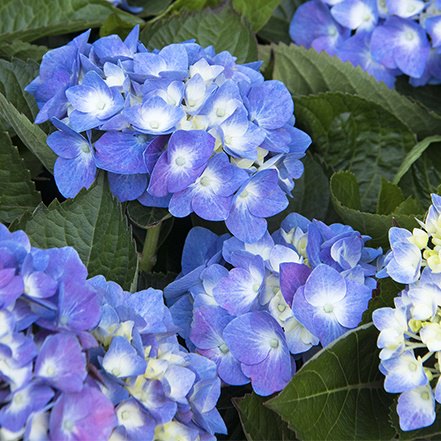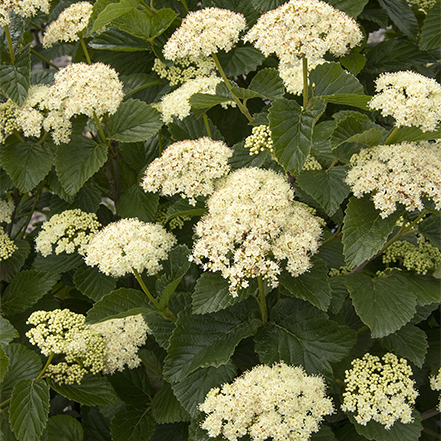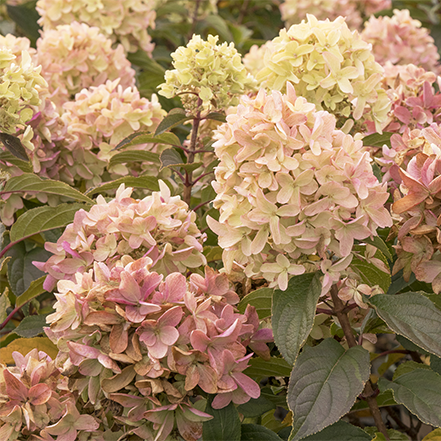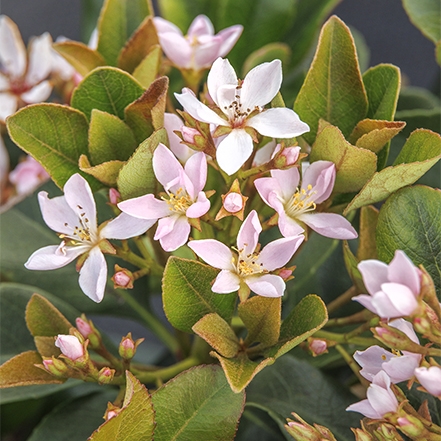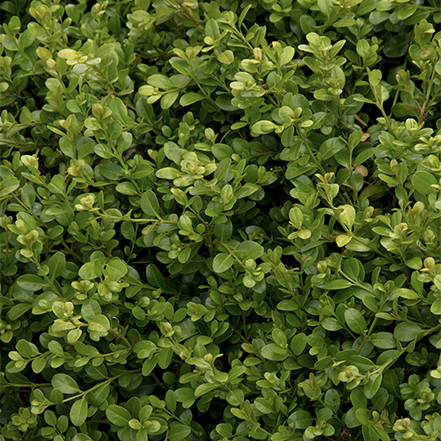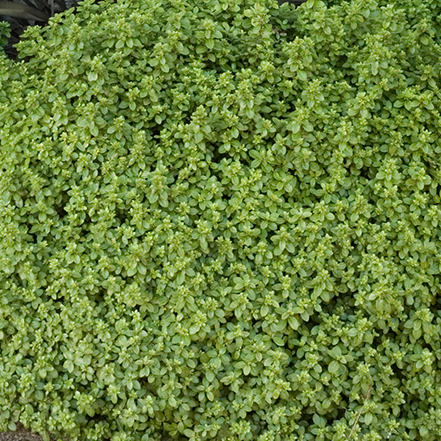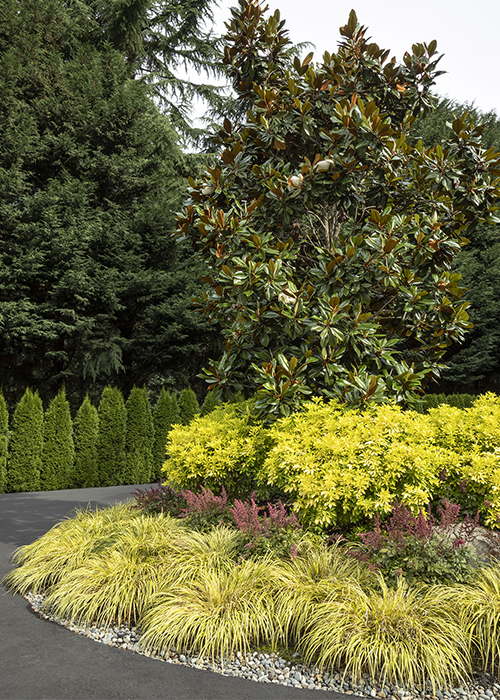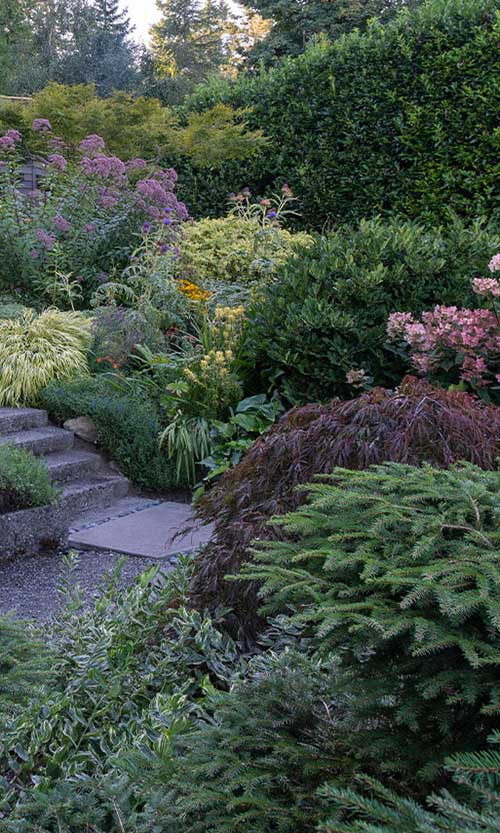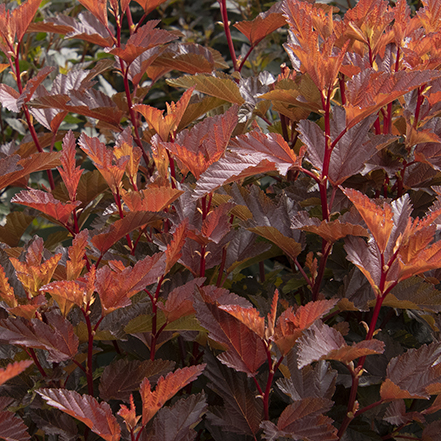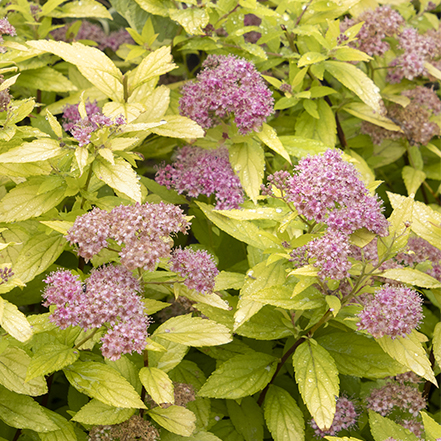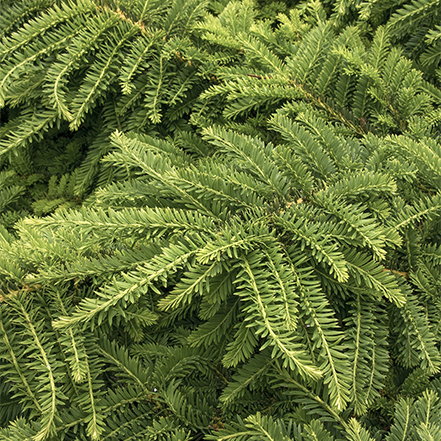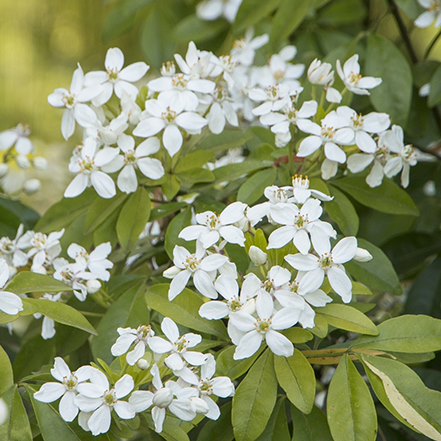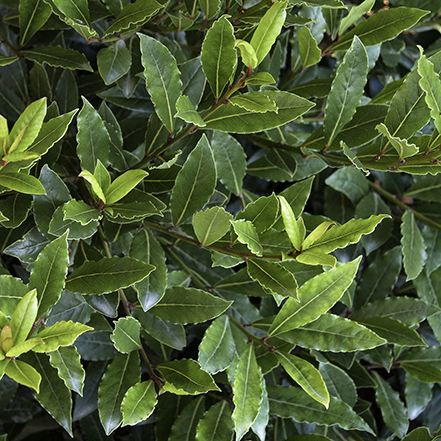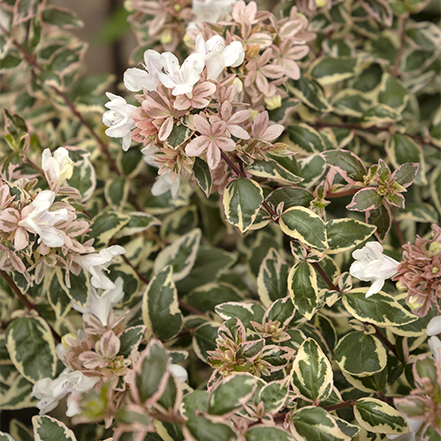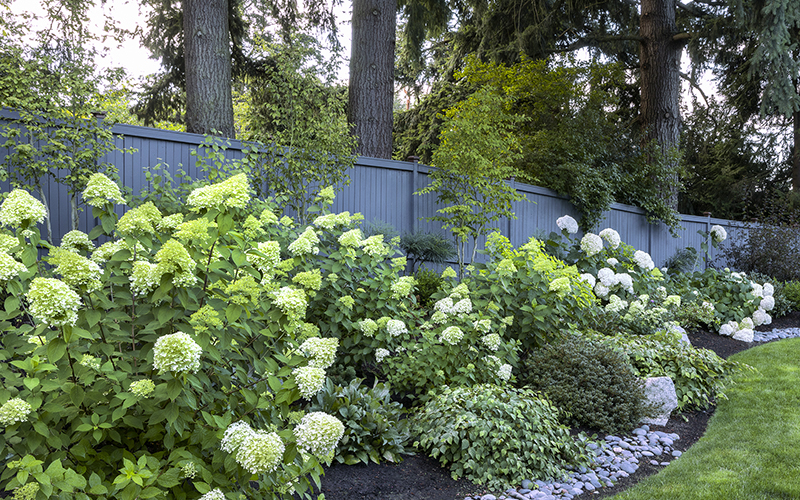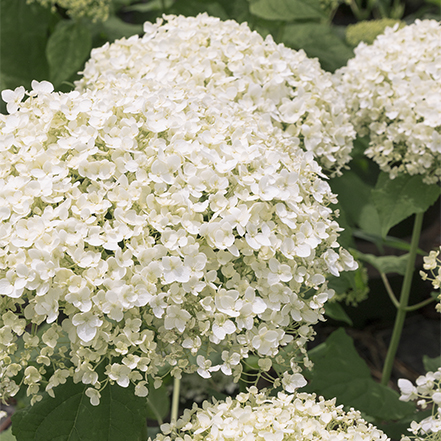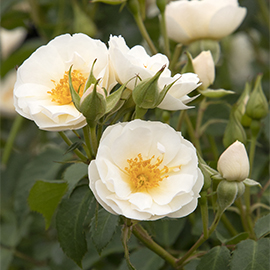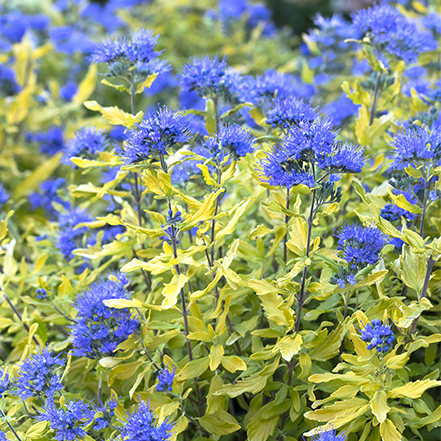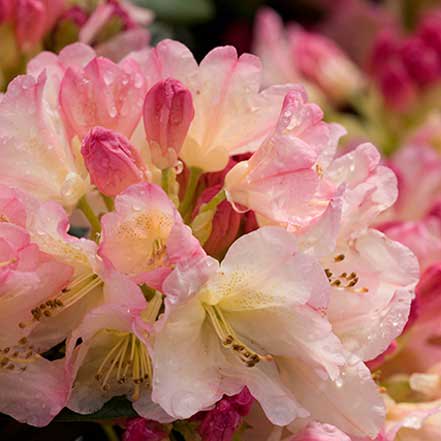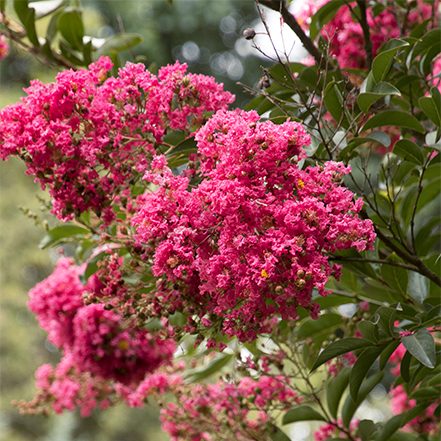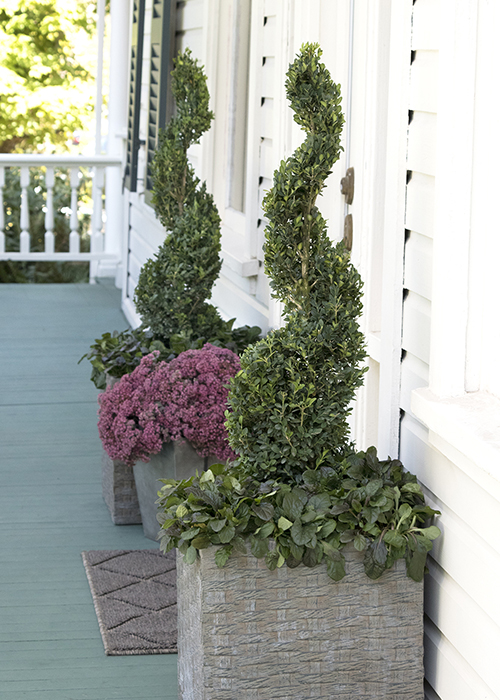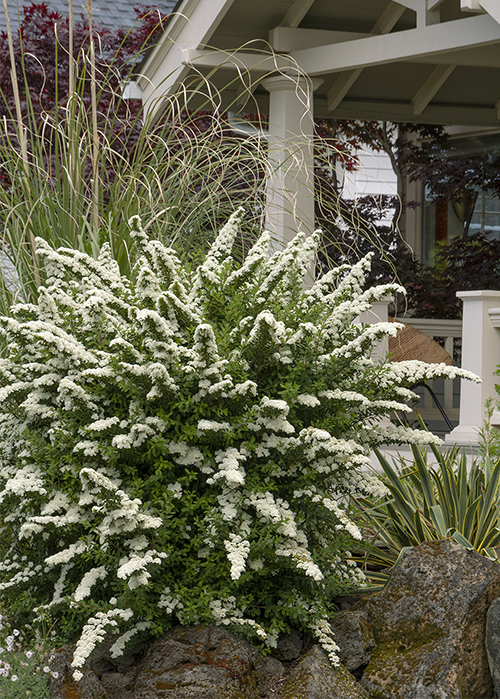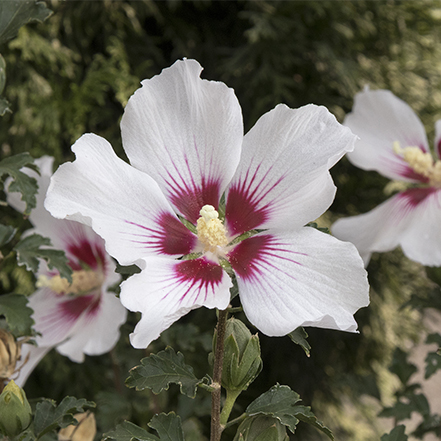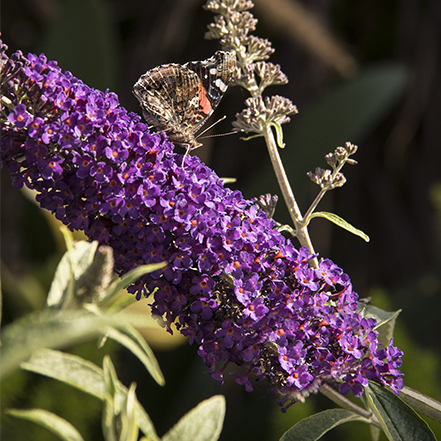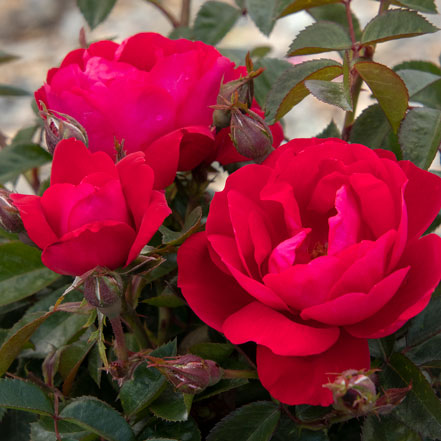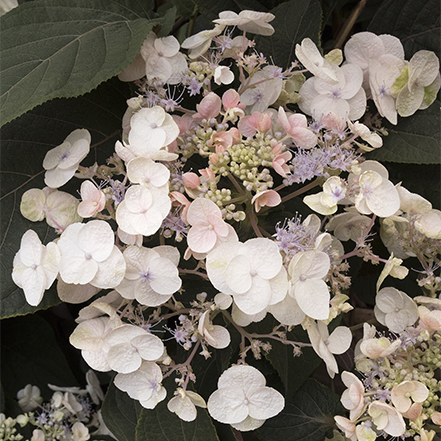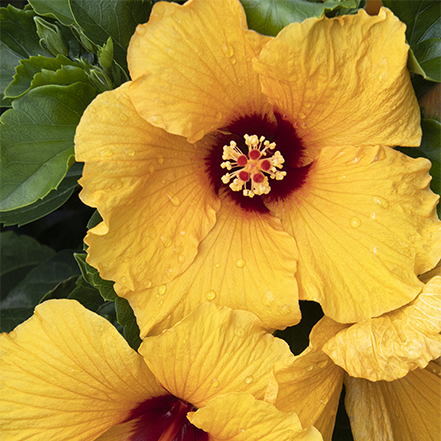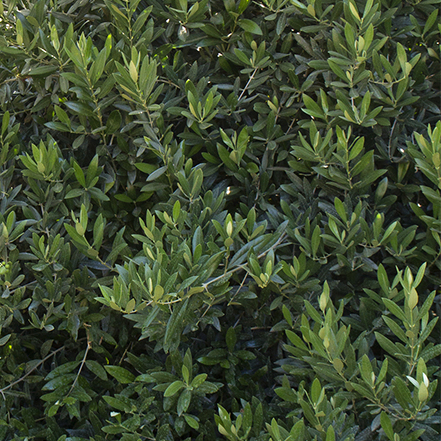Shrubs are often overshadowed by bright, dramatic, and quick-impact perennials, and are easily overlooked by gardening beginners. But experts agree that they are essential to beautiful garden design. Along with trees, shrubs should be the first addition to any new garden space. Shrubs are the MVP of garden design because they offer color, texture, and structure when herbaceous perennials and annuals cannot. Plus, most shrubs are incredibly low maintenance, adding an easy beauty to any landscape.
Shrubs offer the best bang for your buck in the garden
Perhaps the reason why novice gardeners tend to bypass the shrub section is the price tag. Mature, high-quality shrubs at your local garden center will cost more than your typical 1-gallon perennials, so it might be a little scary to make the commitment to buying and planting them. However, if you choose the appropriate shrubs and use them in the right way, they will give you the biggest value in the landscape, offering long-lasting benefits that simply can't be touched by their less-expensive perennial companions.
So how can you utilize shrubs to their potential? Here are five landscape design ideas to unlock garden success with shrubs, plus some specific plant choices (for every zone) to get you started.
To get the most out of your garden, you need to extend the season of its beauty. That means planting perennials, trees, and shrubs that offer colorful and textural interest at various times of the season. Shrubs offer a fantastic way to do that, including many options that provide year-round interest through their structure, foliage, and bloom.
The above pictures illustrate how shrubs can make a huge impact in a garden in the "shoulder seasons" of spring and fall. On the left, an early-flowering forsythia shrub is paired with an early-flowering plum tree. They make a spectacular spring statement combination.
On the right is a fabulous example of a shrub planting that is lush with textural and colorful interest. The rich burgundy and purple tones of smoke bush and ninebark mingle with the rich gold of globe arborvitae and the pink berries of FloralBerry® Pinot St. John's Wort.
Which shrubs add spring interest?
Look for shrubs with vibrant new foliage growth or early-spring flowers. Early-blooming shrubs include Camellia japonica, lilac, daphne, forsythia, sand cherry, azalea, chokeberry, blueberry, mahonia, witch hazel, and pieris. Find more early-blooming favorites here.
Which shrubs add fall interest?
Look for shrubs that produce berries and/or have foliage that changes color in fall. Some of our favorite shrubs for fall color include St. John's Wort, blueberry, crape myrtle, smoke bush, ninebark, panicle hydrangeas, and spirea.
Shrubs for Spring Color
Banana Split®
Daphne
An exceptional selection with variegated foliage, each leaf with a wide yellow edge. Rose-pink buds open to white, sweetly fragrant flowers. Great foundation plant in dappled shade. Place near a walkway or patio to enjoy its fragrance. Full shade to partial sun. 4' tall and wide. Zones 7-9.
Springshine™
Forsythia
A cheerful herald to spring with densely massed, bright yellow blooms that sheathe the stems from bottom to top on this compact, rounded, deciduous shrub. A beautiful accent to mixed borders or foundation plantings, or use en masse to create a low, informal hedge. Partial to full sun. Up to 2' tall, 3' wide. Zones 4-9.
Little Darling®
Lilac
What's better than a fragrant lilac? One that blooms twice a year! Large clusters of dark-purple buds open to classic lilac-hue flowers. This Monrovia exclusive blooms heavily in spring, with a second, lighter bloom set in fall. Compact, with a nicely rounded shape, perfect for containers and mixed borders. Full sun. 4' tall and wide. Zones 4-8.
Shrubs for Fall Color
FloralBerry® Sangria
St. John's Wort
Clusters of golden, cup-shaped flowers bloom in summer on well-branched, rust-resistant plants with handsome dark-green foliage that's accented by deep-red undersides. Stems of red berries make a big impact in the fall garden. A fuss-free deciduous shrub ideal for borders and containers. Partial shade to full sun. Up to 3' tall and wide. Zones 5-9.
Lilla
Smoke Bush
A dwarf form perfectly proportioned for smaller gardens. Forms a small, rounded, deciduous shrub with all of the color and interest of its larger cousin. Frothy plumes of pink flowers rise above the wine-red foliage in the summer, and the oval leaves turn shades of bright orange, coral, and red in the fall. Partial to full sun. Up to 4' tall and wide. Zones 4-8.
Magic Carpet
Spirea
A neat, compact, mounded shrub with vibrant red new leaves. Clusters of small pink sping-blooming flowers contrast with bright-gold mature foliage that turns rich russet red in fall. This extraordinary combination of colors will brighten and enhance any landscape. Full sun. Up to 24" tall and wide. Zones 4-9.
2. Shrubs Make Perfect Foundation Plantings
Foundation plantings are one of the most important elements of curb appeal. Foundation shrubs form the backbone of front yard gardens and are often the most long-lived part of the front landscape.
The photo above illustrates how landscape designer Robin Parsons creates a gorgeous foundation planting with hedge of blue-flowering hydrangea (this is 'Nikko Blue' but Seaside Serenade® Cape Cod Hydrangea is great, more compact option) that cools down the brilliant yellows of the surrounding shrubs and creates a focal point at the front door. The red-flowering Fanal Astilbe provides a fantastic contrast at the front of the bed, too. See more of this beautiful landscape here.
Foundation shrub planting tip: Remember to plant your foundation shrubs 3-4' away from the house and be sure to give them the appropriate amount of space between each other based on their mature size.
What is a foundation shrub?
A foundation shrub is one that is planted near the foundation of your home. Foundation shrubs soften and hide the foundation of your home. They also form the back layer of a garden bed against the house. They should be planted in massed groups of three or more to achieve a cohesive look. Foundations shrubs can be utilized on all four sides of your home, but are best known for their key role in the front bed of the house, near the entryway.
What makes a good foundation shrub?
Form (or habit), light and moisture needs, and mature size are the most fundamental details to be aware of when choosing your foundation shrub. And of course, it should be appropriate for your region and growing zone. Midsize shrubs with a nicely rounded or mounded growth habit typically make the best foundation shrubs. You want something that won't overwhelm your space or hide your windows (if there are any in the area) when it's fully grown.
Bloom size, color, and season can make a difference in your choice, as well. It's also helpful to consider your house color and style when choosing the flower and foliage color of the shrubs you'll be planting right in front of it.
There's a vast array of shrubs that could make for a beautiful foundation planting, but it's common to see hydrangea, boxwood, Viburnum, Indian hawthorn, Euonymus, and Pittosporum used as foundation shrubs across the country.
Favorite Foundation Shrubs
Seaside Serenade®
Cape Cod Hydrangea
A new classic for small spaces! A hardy, repeat blooming machine with big, mophead flowers, extra-dark green leaves, and a neat, mounded form. Perfect for foundations and borders. Blue florets in acidic soils, or pink in neutral to alkaline soils. Partial shade to partial sun. Up to 4' tall and wide. Zones 4-9.
Sparkler® Arrowwood
Viburnum
A densely branched, upright, deciduous shrub with lustrous, dark green, ruffled foliage that turns bright yellow to red in fall. Creamy white, flat-topped umbels give way to large clusters of showy blue-black berries that will delight birds. A hardy and reliable foundation plant and border background. Partial to full sun. Up to 15' tall and wide. Zones 4-9.
Strawberry Shake™
Hydrangea
A gorgeous new panicle hydrangea, in a much more compact form. Sturdy stems support big, full flower heads that start out white and mature to a delectable pink. The long-lasting blooms are superb in fresh or dried arrangements. A summer show-stopper for containers, or use as a foundation shrub in smaller gardens. Full or partial sun. Up to 5' tall, 4' wide. Zones 4-8.
Eleanor Taber™
Indian Hawthorn
Produces profuse clusters of pink flowers. Young leaf-spot-resistant foliage is often bright red-orange, maturing to a deep green. Blue-black berries accompany deep maroon winter foliage. An excellent groundcover, hedge, accent, or foundation shrub. Partial to full sun. Up to 4' tall, 3' wide. Zones 7-10.
Green Beauty
Boxwood
An excellent evergreen shrub for small hedges and foundation plantings. Retains its dark green foliage in the hottest summers, becoming bronze-tinged in cold weather. Well-suited to pruning into formal shapes. More heat, humidity, and drought tolerant than other boxwood varieties. Full to partial sun. Up to 6' tall and wide. Zones 5-9.
Golf Ball
Pittosporum
This dense, formal, low-maintenance form is ideal in containers or as a low hedge or foundation planting in place of a boxwood. Also a great choice to line a walkway or surround a rose or perennial garden. Maintains a naturally rounded shape that seldom needs pruning. Partial to full sun. Up to 4' tall and wide. Zones 8-11.
3. Shrubs Create Layered Drama
Shrubs are essential to beautifully layered landscapes. Try combining them with low-growing spreaders, medium-height perennials, and compact trees to strike the perfect balance in just about any landscape.
The pictures above illustrate how two Northwest-based landscape designers, Robin Parsons and Susan Calhoun, create lush, dynamic, and absolutely stunning layered plantings with shrubs in two very different landscapes:
(Left) Bracken's Brown Beauty Magnolia is layered with the striking chartreuse new foliage of Sundance Mexican Orange Blossom shrubs and All Gold Japanese Forest Grass and further amped up with the red blooms of Fanal Astilbe, this layered scene makes a statement at the driveway entrance in a Seattle-area home. Read more about Robin Parson's approach to layered planting in low-water shade gardens here.
(Right) Osakazuki Japanese Maple, Shipka Cherry Laurel, Bartzella Itoh Peony, Little Ragu® Sweet Bay, Ruby Slippers Hydrangea; Variegated Solomon’s Seal, Crimson Queen Japanese Maple, Nest Spruce. Learn more about designer Susan Calhoun's peaceful, multi-layered landscapes here.
How to use shrubs to layer a garden bed
Shrubs come in a variety of shapes and sizes, so they can be used in a variety of ways to layer a garden bed. The simplest way to think about layering a garden bed is by planting from high to low. Your tallest plants—often trees or shrubs—will be at the back. Your middle layer will be filled with mid-sized plants, which could be shrubs, grasses, and perennials. The front layer of the garden bed should be the lowest-growing plants. Again, some low-growing shrubs are great for this role. Compact perennials and grasses can be ideal here, as well as groundcovers of all kinds.
As you may have noticed, paying attention to the expected mature size, shape, and habit of plants is crucial to creating a beautifully layered garden bed or border.
Favorite Shrubs for Layered Beds and Borders
Lil' Sizzle®
Spirea
This exceptionally tough and compact variety packs a double punch with bright orange new foliage that matures to gold, and hot pink flowers that appear in spring, and then again in summer. Tolerates full sun without burning, and adapts to poor, compacted soils. Partial to full sun. Up to 3' tall and wide. Zones 4-9.
Emerald Spreader®
Japanese Yew
This exceptional, cold hardy, evergreen shrub is a perfect low-maintenance choice for groundcover, large-scale borders, or a low hedge. Strong and sturdy, it provides good erosion control on slopes. The attractive dark green foliage retains its color in the coldest of winters. Partial to full sun. Up to 3' tall, spreading up to 10' wide. Zones 4-7.
Sundance Mexican
Orange Blossom
Bright chartreuse to golden-yellow, glossy foliage provides year-round color and contrast to shrub and perennial borders. Showy clusters of sweetly fragrant, orange blossom-like, white flowers are a delightful bonus. Full sun. Up to 6' tall and wide. Zones 7-10.
Little Ragu®
Sweet Bay
A more compact sweet bay with highly aromatic, deep-green foliage that emerges on unique red-tinged stems. Handsome in natural form, or easily clipped into a formal hedge. Thrives in containers, too. Partial to full sun. Up to 8' tall and wide. Zones 8-11.
Magic Daydream
Abelia
A total knockout, with glossy green and white variegated foliage. This reliable shrub attracts hummingbirds with large, fragrant blooms that change color from white to pink. Perfect for borders, containers, and as a specimen in the garden. Waterwise once established. Partial to full sun. Up to 2' tall and wide. Zones 6-9.
4. Use Shrubs En Masse for Lush, Colorful Borders
Mass planting, or planting in drifts, is the simplest way to make a big impact in your landscape. The swaths of color and texture create a cohesive look that can knit a garden together with a seamless appeal. With the right shrub choice, you can enjoy a lush border of any size that requires little to no care in exchange for its dependable beauty. Plus, massed shrubs are perfect for creating privacy screens, green fences, and the underlying structure of your garden.
In the above picture, you can see how massed hydrangeas create a gorgeous swath of lush foliage and big blooms along a fence in a landscape designed by Robin Parsons, who explains, "planting in groups creates more impact than random planting." Tall trees at the back of the bed and low-growing shrubs at the front create the layered effect outlined in #3 above, making this a superb example of how to design a border that is dynamic in height, structure, and color.
Learn more about the "what why and how" of mass planting here to take your garden design skills to the next level. You can read the full interview with Robin that's quoted above here.
Favorite Shrubs for Mass Plantings and Borders
Seaside Serenade® Bar
Harbor Hydrangea
This new, compact form of the famed Annabelle hydrangea is perfect for smaller spaces. Masses of big, white flower heads put on a spectacular show throughout summer, and the straight sturdy stems hold up even in heavy rain. Ideal for borders or in containers. Partial to full sun. Up to 4' tall and wide. Zones 3-8.
Nitty Gritty™
White Rose
These durable, own-root, fuss-free groundcover roses offer excellent disease resistance and a self-cleaning easy-to-care-for habit. White double blooms provide vibrant warm-season color and are the perfect option for low-maintenance curb appeal. Full sun. Up to 3' tall, 4' wide. Zones 4-9.
La Barbe Bleue™
Bluebeard
A hardy, drought-tolerant, and low-maintenance shrub that has a neat, compact habit. A profusion of deep-blue flower spikes offers a gorgeous contrast to the dramatic foliage as well as nectar for bees and butterflies. Full sun. Up to 26" tall, 30" wide. Zones 5-9.
Percy Wiseman
Rhododendron
Lovely spring flowers emerge in shades of peach, pink, and cream. This is a versatile, vigorous, and evergreen shrub that's perfect for mass planting, low hedges, accents, and foundation plants. The thick green leaves have velvety tan undersides. Partial sun. 3' tall, 4' wide. Zones 5-9.
Champion
Hebe
A compact, colorful selection of a versatile shrub that is known to be reliable and easy to maintain. Violet flower spikes attract butterflies. A favorite for Northwest gardens, and a wonderful addition to a rock garden, front border, or container. Partial to full sun. Up to 18" tall, 24" wide. Zones 7-11.
Summerlasting™ Strawberry
Crape Myrtle
Dense, bright-pink blooms cover this low-maintenance shrub in summer, making for a dramatic display that attracts pollinators. A compact, dwarf variety that's perfect for smaller landscapes. Plant en masse for a vibrant swath of color. Waterwise once established. Full sun. Up to 3' tall and wide. Zones 7-10.
5. Single Shrubs as Specimen Plants in Containers and the Landscape
Big or small, every garden has room for a specimen shrub of some kind, and the garden is always more dynamic thanks to them. Shrubs make for fantastic specimens to anchor a garden bed, add unique color and/or texture, offer vertical interest, highlight an entryway, and, as designer Robin Parsons puts it, offer a "focal point where the eye can rest."
Specimen shrubs like topiaries (Green Mountain Boxwood topiaries are pictured above), potted patio trees, and other shrubs in containers make a big impact when flanking an entrance. Take a look at how the Snowmound Spirea pictured above makes a statement in a smaller front yard landscape. The profuse spires of white blooms instantly draw your eye in spring, and the graceful arching habit looks fantastic when the flowers run their course.
What is a "Specimen Shrub"?
A specimen shrub is a shrub that acts as a focal point in the landscape. They garner special attention thanks to a variety of impressive elements that may include structure, texture, bloom, color, shape, or stature. Specimen shrubs can also be accent shrubs, which play a similar role in the landscape. Specimen shrubs also act as an anchor in the garden, providing structure and height in the bed.
What makes a good specimen shrub?
The one requirement for a specimen shrub is the ability to be a visual focal point in the garden. However, as mentioned above, there can be a variety of aspects of a shrub that might meet that requirement. The best specimen shrubs reflect the taste of the gardener and the style of the garden. For example, dense, sculptural shrubs and topiaries are ideal for formal gardens, while looser, more floriferous shrubs are perfect for meadow and pollinator gardens. The important thing is that you find the shrub to be beautiful and worthy of showing off.
Favorite Shrubs to Use as Specimens or Accents
Chateau™ de Chantilly
Rose of Sharon
The large, exquisite, white flowers cover the stems from top to bottom, each featuring a deep red-violet center and prominent stamina. An excellent shrub that offers height and scale, show-stopping blooms throughout summer, and attractive green foliage. Partial to full sun. Up to 6' tall, 4' wide. Zones 5-9.
Black Knight
Butterfly Bush
Spectacular summer color from lightly fragrant, dark violet-purple flower spikes. A fast-growing shrub that works well as a foundation shrub, an accent plant, or as a background in borders. Partial to full sun. Up to 8' tall, 6' wide. Zones 5-9.
Grace N' Grit™
Pink Shrub Rose
Upright bouquets of beautiful, pink, double roses on a fuss-free shrub that will endure the trials of a long, hot summer with unwavering blooms. This own-root rose has outstanding disease resistance, is self-cleaning, and has proven to thrive coast to coast in heat and humidity as well as dry, hot summers.
Full sun. Up to 5' tall, 4' wide. Zones 4-9.
Plum Passion®
Improved Hydrangea
A delightful, densely branched hydrangea with green-purple new foliage that ages to a deep purple with rosy purple undersides and is contrasted nicely by bicolor lacecap summer blooms. Captivating fall foliage develops golden topsides while retaining its purple undersides. A wonderful accent for shady borders and cottage gardens. Partial to filtered sun. Up to 6' tall and wide. Zones 7-10.
Jazzy Jewel®
Gold Hibiscus
This dazzling gem produces a prolific amount of large, long-lasting, golden-yellow flowers with a deep red eye on lush, glossy green foliage. An outstanding selection for bold, exotic color in warm, sunny, tropical gardens, or adds an exotic flair to containers. Up to 5' tall and wide in the landscape where hardy. Zones 9-11.
Little Ollie®
Dwarf Olive
Dwarf, non-fruiting evergreen with a graceful, multi-branching habit. Deep green leaves have silvery green undersides. Attractive as a formal hedge or specimen shrub. Excellent in topiary form, or trained as a single trunk tree in smaller spaces. Heat, drought, and salt tolerant. Full sun. Up to 6' tall and wide. Zones 8-11.
Get more garden design help with these resources:
- Find your local garden center to ask if they carry the featured plants.
- Sign up for the Grow Beautifully newsletter to get first access to exclusive digital design guides, webinar invites, and helpful stories like these delivered straight to your inbox.
- Browse stories with lessons from garden design experts
Free Digital Design Guides:
- Backyard Habitat Guide
- Landscape Style Guide Lookbook
- Simply Beautiful Design Guide
- Plant Palette Color Guide
- Drought-Tolerant Gardening Guide
Webinars:
